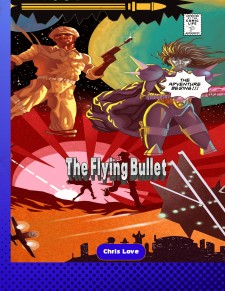| My t-shirt. You can order at Teezily.com/science-wetheppl (I get no commission). |
Featured Posts (3520)
 |
| From Nature: “The inner walls of the water tank are covered by a reflecting foil improving the light detection. This permits the identification of cosmic muons.” Image: K. Freund, GERDA collaboration |
 |
| Image Source: Origami Resource Center |
 |
| Image Source: wiseGEEK |
Topics: Civics, Existentialism, History, Politics
 |
| Image Source: BBC. Did early Mars have a vast northern ocean? |
| Credit: Getty Images |
Be Like a Bullet...Be Unstoppable

The Flying Bullet: Graphic Novel/Film---A Sci-Fi; Story going from the Cotton Field to Outer Space
Huntsville, Alabama, March 29, 2017 (Newswire.com) - Heroes Like Me Entertainment will release a graphic novel and film called THE FLYING BULLET. It is the tale of Tuskegee Airman, Lt. Curt Masters, who is kidnapped by aliens and has to fight for an Earth that doesn't fight for him. This project has been six years in the making.
Lt. Curt Masters, a Tuskegee Airman, is flying a combat mission over the skies of Nazi Germany in 1945. He encounters an alien craft. He engages the craft unsuccessfully. Soon, he is aboard the UFO and is charged with Obstruction of Galactic Operations. He and the people of earth are on trial for their survival. Can Curt Masters free himself from over a billion miles away? Will he ever return home? Or will he die at the hands of The Warlord. In this new universe, he meets Aliena-a Galactic Police officer, Sutter-a mysterious friend or foe and ARC, who is an android without a will of his own. Curt will learn that once you Look Forward you can Never Go Back. Written by Chris Love, this graphic novel offers new worlds and possibilities. A companion feature film has been adapted from this graphic novel.
This is not a Hollywood blockbuster, but a film by one person, Christopher Love. This film is an independent film made by a fan of sci-fi for fans of sci-fi. The characters in the film will be of african-american, asian and hispanic descent.
"During World War II, Black and White Lives, including First Lady, Eleanor Roosevelt; petioned the government to allow Black Americans to fight and defend their country by training them to fly. All they asked in return was the opportunity to enjoy in the blessings of our great nation. This story is about one person who had to fight and defend the whole planet," says Chris Love.
This graphic novel/film is in the direct response to the lack of diversity in Science Fiction and Fantasy.
"We've waited for Hollywood to present stories of the future that has more than Caucasian characters in it. The Future is for everyone, but on the big screen I do not always see someone like me or my kids in that future. I'm doing this for them and other kids of color and diversity who deserves to see themselves on the big screen, tablet or phone to enjoy. Everyone deserves heroes that look like them," says Chris Love.
This is Mr. Love's first graphic novel and film. He has been writing for over 20 years. He is the Chief Creative Officer of Heroes Like Me Entertainment.
Mr. Love concludes by saying, "If you want something you never had, you must do something you never did."
The Flying Bullet can be found on Amazon.com. Go to heroeslikeme.com
Source: Heroes Like Me Entertainment
| Image Source: Mining.com link below |
Topics: Alternative Energy, Economics, Jobs, Robotics
Brookings Institute
Increased automation guarantees a bleak outlook for Trump’s promises to coal miners,
Devashree Saha and Sifan Liu
Mining.com
Study shows 96% of some mining jobs can be automated,
Frik Els
New York Times
Coal Miners Hope Trump’s Order Will Help. But Few Are Counting on It,
Campbell Robertson
Policy Shift Helps Coal, but Other Forces May Limit Effect,
Clifford Krauss and Diane Cardwell
Planned Rollback of Climate Rules Unlikely to Achieve All Trump’s Goals,
Coral Davenport
 |
| NASA will use CAL to better try to understand a highly misunderstood type of matter in space. Image Credit: NASA |
Dust off those old specfic flashfics and short stories you’ve got lying around.
Spec Fics is now accepting submissions from Guest Authors who would like to showcase their overlooked works on our website. To that end, we are now accepting short works of fiction to be made available for free online reading.
We welcome speculative flash fiction and short stories. All sub-genres that fit under the umbrella of speculative fiction are welcome: scifi, horror, dark fantasy, steampunk—you name it.
For information on how to submit your story, here are the Submission Guidelines:
Submission Guidelines
Email your story as an attachment to tonyamoore@outlook.com.
Your story should be in RTF (Rich Text Format) or DOCX (Word) format. Be sure to include your name and email address in the story document.
Include the following information in the body of your email:
Name:
Short Bio:
Picture (Optional):
Website/Blog Url:
Previously blogged/published stories are welcome.
We do stipulate that your story must be your original work. Sorry, no Fan Fiction.
 |
| Does the brain behave like a spin glass? (Courtesy: Shutterstock / Phonlamai Photo) |
 |
| An aurora viewed from the International Space Station. Credit: NASA |
Check out this short film featuring Conscious Metal Sounds & Wholistic Visuals from a Thrash-Hop Rock Band featuring musicians I played on and off the radio from my DJ Days - GOD BLESS - D-Rock SOUL-Jah!!!
 |
| Image Source |
 |
| Image Source |



